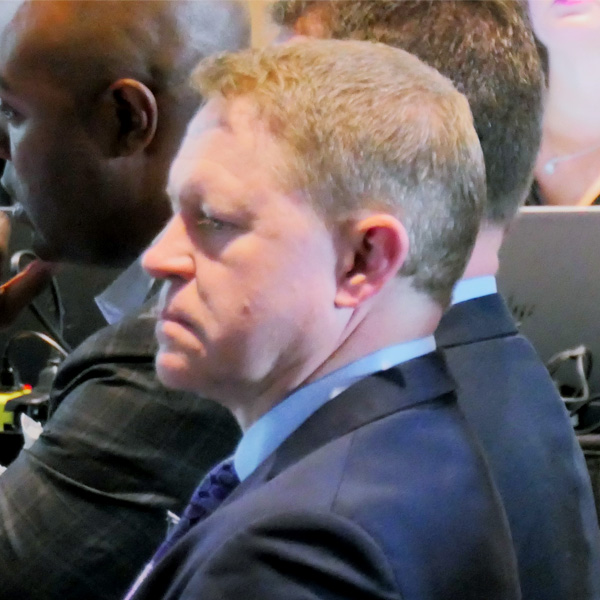Sen. John Hickenlooper (D-Colo.) and Rep. Scott Peters (D-Calif.) on Friday introduced the Building Integrated Grids With Inter-Regional Energy Supply (BIG WIRES) Act, which would require minimum levels of interregional transfer capability between regions.
The two have been working on the bill for months. It was discussed during the debt ceiling negotiations earlier this year, but ultimately not included in the package that passed. (See Debt Ceiling Bill Provides ‘Mini-deal’ on Permitting.)
“If we want to maintain our national security amidst growing international conflict, make our power system more reliable and cut high energy costs for Americans, we can’t have a faulty, outdated electric grid,” Hickenlooper said in a statement. “Our bill advances two priorities simultaneously: Make electricity more affordable and build a power grid fit for the 21st century.”
The bill would direct FERC to better coordinate construction of an interregional transmission system by requiring each of its transmission planning regions (that date from Order 1000 and include jurisdictional ISO/RTOs) to be able to transfer 30% of their peak electric loads to their neighbors.
The lawmakers compared the current development of the transmission grid to building new highways that crisscross the country every time two towns need to be connected. They say their bill would close current gaps in the transmission network by doing the equivalent of “building new exit ramps off the existing interstate.”
“During a heatwave, hurricane or other natural disaster, the last thing you want is for the power to go out. It can be the difference between life and death,” said Peters. “There is no reason neighboring electrical grids should not have the capacity to share power during these situations to avoid blackouts. The associated buildout of electric transmission lines would greatly improve reliability and keep costs down for consumers. BIG WIRES will help get clean, reliable energy from where it is produced to where it is used by people, but above all else, it is an American energy security and independence bill.”
On top of the reliability benefits, the legislation also would reduce energy costs by allowing regions where power prices are cheaper to sell into regions where it’s more expensive and by allowing all regions to connect new, low-cost resources to the grid.
The bill aims to be technology neutral, allowing all types of generation to connect to the grid and relieve grid congestion where needed. The lawmakers said it would prioritize regional flexibility by allowing the FERC planning regions to decide how they will upgrade their systems.
The bill has a section devoted to ERCOT, which never has had much interconnection with the Western and Eastern Interconnections, giving the Texas PUC authority over its wholesale markets and transmission planning. The PUC “may, at its sole discretion” choose to support the reliability and affordability of the Texas grid by voluntarily complying with a minimum transfer capability equal to a percentage, determined by ERCOT, of its coincident peak load, the bill said.
The two offices released a suite of supportive quotes from clean energy groups, transmission supporters, environmentalists and some former regulators who were on the FERC-State Joint Task Force on transmission, where the idea of interregional transfer capacity was widely supported. (See States Back FERC Interregional Transfer Requirement.)
Former FERC Chairman Rich Glick noted that recent years have seen extreme weather test the grid and the bill would help deal with those situations by increasing interregional transfer capability.
“Utility customers are at greater risk of losing access to power during extreme weather events, and they are often forced to pay much more for electricity than they otherwise would with a more efficient electric grid,” Glick said in a statement. “Senator Hickenlooper and Congressman Peters deserve credit for elevating this important subject with the introduction of the BIG WIRES Act.”
The legislation also won praise from Glick’s former colleague from across the aisle, former FERC Chairman Neil Chatterjee.
“By requiring that FERC establish a minimum interregional transfer capability standard, this important legislation will dramatically improve our country’s ability to move power between regions where and when it’s needed most, enhancing grid reliability for all Americans,” he said in a statement.
Former Maryland PSC Chair and FERC-State task force co-chair Jason Stanek also gave the proposal a supportive quote.
“Increasing interregional transmission capacity will be critical to maintaining reasonable utility rates and sustaining a reliable bulk power system,” Stanek said. “This bill builds upon recent discussions by the Joint Federal-State Task Force which highlighted the important role that interregional transmission will play as we strengthen our nation’s power grid.”
Other backers of the legislation include Americans for a Clean Energy Grid, American Clean Power Association, American Council on Renewable Energy, Advanced Energy United, Business Council for Sustainable Energy, Clean Energy Buyers Association, the Electricity Consumers Resource Council, Environmental Defense Fund, Natural Resources Defense Council, Rocky Mountain Institute, the R Street Institute and the Solar Energy Industries Association.
The bill could become part of a broader effort on permitting, which has a chance of passing this year. On Thursday, Senate Energy & Natural Resources Committee Chair Joe Manchin (D-W.Va.) and Ranking Member John Barrasso (R-Wyo.) released a joint statement saying they agreed on the need to change permitting laws and regulations generally.
“We are in agreement that we must act to accelerate our permitting system and are committed to reaching a bipartisan solution that prioritizes American energy security, reliability and affordability,” the two said.

